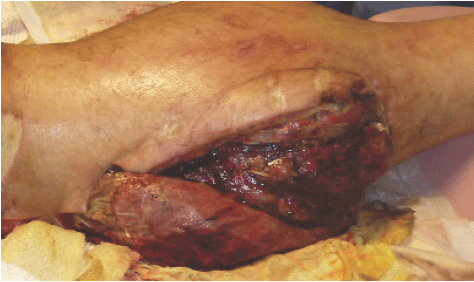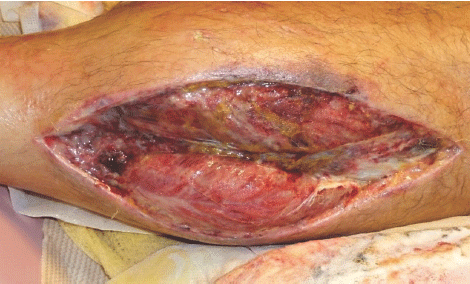The medial calf wound post-HBOT still shows obvious edema, but appears well perfused and shows no signs of necrosis or infection.

Dawnielle C. Endly1, Joan V. Eggert2
doi: http://dx.doi.org/10.5195/ijms.2013.211
Volume 1, Number 2: 91-93
Received 09 09 2012: Accepted 02 02 2013
ABSTRACT
Background:Fasciotomies are a therapeutic treatment for compartment syndrome, but they also allow reperfusion to tissues that have been hypoxic. We report a case study of a 52-year-old male with an ischemic leg. Despite prophylactic fasciotomies, ischemia-reperfusion injury resulted in delayed myonecrosis and progressive necrotizing fasciitis.
Results:After two hyperbaric oxygen treatments, edema was markedly reduced and all visible wound tissues were well perfused without evidence of ascending infection, allowing the patient more time for further evaluation. The patient did opt for an above the knee amputation in a non-emergent setting and now successfully utilizes a prosthesis for ambulation.
Conclusion:Ischemia-reperfusion injury may result in delayed tissue loss in spite of appropriate fasciotomies. Hyperbaric oxygen may be a useful adjunct therapy even when initiated days after the initial injury.
Keywords: Reperfusion Injury; Hyperbaric Oxygenation; Surgical Decompression.
Acute compartment syndrome of an extremity often occurs after a traumatic injury. As pressure builds within the compartment, the arterioles collapse rendering the tissue hypoxic.1 A fasciotomy can be limb saving as it allows decompression of the involved compartments.2 Paradoxically, however, the decompression allows return of blood flow which can result in further tissue damage known as ischemia-reperfusion injury. Hyperbaric oxygen therapy (HBOT) is useful as an adjunct to fasciotomies where it is likely that ischemia-reperfusion injury will result.3 We present a case where HBOT was utilized eight days after a traumatic injury when progressive myonecrosis and necrotizing fasciitis occurred secondary to ischemia-reperfusion injury.
Eight days after a high speed motorcycle accident, a healthy 52-year-old male had deteriorating signs of myonecrosis and evidence of a rapidly ascending necrotizing fasciitis of the left lower extremity. He had been revascularized after tran-section of the proximal popliteal artery approximately seven hours after injury with prophylactic fasciotomies performed at time of initial revascularization. Extensive irrigation and debridement was performed on three occasions due to the wound being highly contaminated and the presence of leukocytosis of 13.5 K/uL on day one. He was placed on Penicillin and Gentamicin prophylactically the day of the injury.
Five days after injury, negative pressure wound therapy (V.A.C® Therapy, KCl, San Antonio, TX) was utilized to control the drainage and Piperacillin-tazobactam was added for continued fevers and a white blood cell (WBC) count that began increasing again. He was extubated on day six, but it became evident that he could not move the foot on command. On day seven, an infectious disease (ID) consult was ordered as the patient had continued fever, WBC count of 14.0 K/uL, a foul odor coming from the leg, and dirty dishwater like secretions exceeding the wound V.A.C. canister capacity. ID recommended adding Linezolid and Ciprofloxacin given the clinical course and wound cultures grew Escherichia coli, Pseudomonas aeruginosa, and Stenotrophomonas maltophilia. By day eight, the WBCs increased to 18.8 K/uL and tissue continued to devitalize and dissolve causing a clinical suspicion of a life threatening necrotizing fasciitis and the surgeon adamantly advised an above knee amputation.
The patient had an altered mental status and refused to consent for amputation. The surgeon requested a psychiatric consult as family members weren’t comfortable with consenting for amputation and requested that he be transported to his home state for a second opinion before deciding that the leg was non-viable.
HBOT was initiated as an alternative to immediate amputation. The patient received two hyperbaric oxygen treatments at 2.8 atmospheres absolute (ATA) and 2.4 ATA respectively within 12 hours in an attempt to slow the myonecrosis and ascending infection. After HBOT, all visible wound tissues were pink, well perfused, and viable (Figures 1a and 1b).
Figure 1.The medial calf wound post-HBOT still shows obvious edema, but appears well perfused and shows no signs of necrosis or infection.

The lateral calf wound post-HBOT shows improvement in the edema and evidence of tissue viability.

Edema was reduced and there was no evidence of a progressive ascending infection so he was immediately transferred by air to the care of a trauma surgeon at a specialty hospital closer to his home. After further assessment, it was determined the sciatic nerve was completely severed above the knee, and the leg would be incapable of regaining motor activity. The patient did opt for an above the knee amputation in a non-emergent setting with family support and full informed consent. The limb healed well after amputation and he now successfully utilizes a prosthesis for ambulation.
Fasciotomies have long been the standard of care in patients suffering from acute compartment syndrome. However, this case illustrates that resulting ischemia-reperfusion injury may cause delayed tissue necrosis in spite of appropriate fasciotomies and HBOT can be utilized as a viable therapeutic adjunct. The mechanisms behind ischemiareperfusion injury begin with cellular hypoxia which creates a shift to anaerobic metabolism and accumulation of anaerobic byproducts. Fasciotomies re-introduce oxygen into this distorted environment. As a result, free radical formation increases, inflammatory mediators aggregate, the mitochondria sustain structural damage, the sodium-calcium pumps are disrupted, and the complement system is activated.1,4
In addition, endothelial cells increase the expression of adhesion molecules, such that re-perfusion increases neutro-phil attachment. The resulting release of reactive oxygen species from bound neutrophils activates complement and ultimately induces tissue necrosis.4
While HBOT does not replace a fasciotomy, it has several mechanisms of action that are useful to compromised and contaminated tissue. First, the hyperoxia improves oxygen delivery to tissues in need and prevents infections due to anaerobic microorganisms. Leukocytes also utilize hyperoxia for the neutrophil’s oxygen dependent bacterial killing. Additional oxygen in reperfused tissues results in the generation of free radical scavengers such as superoxide dismutase to neutralize the waste products of anaerobic metabolism.5 Moreover, hyperbaric oxygen inhibits the diapedesis of neutrophils on post-capillary venules by antagonizing the Beta 2 integrin system.6 Overall, HBOT maintains oxygenation of the tissues that have become compromised, reduces risk of infection, and down-regulates the inflammatory response.5-6
Ideally HBOT is started within hours of injury, but this requires the patient to be stable enough to tolerate the treatment. Most hyperbaric centers in the United States, including ours, primarily treat stable outpatients, not intubated and critically ill patients. Thus, we could not have treated this patient before he was extubated. In this case HBOT was utilized to treat a secondary progressive myonecrosis and necrotizing fasciitis to allow the patient and family time to make an educated decision on moving forward with amputation of the limb. Further discussion about the use of HBOT as an adjunct to fasciotomies is needed before conclusions regarding the expected clinical course and outcome can be made.
None.
The Authors have no funding, financial relationships or conflicts of interest to disclose.
1. Wattel F, Mathieu D, Neviére R, Bocquillon N. Acute peripheral ischaemia and compartment syndromes: a role for hyperbaric oxygenation. Anaesthesia 1998;53Suppl 2:63.
2. Masquelet AC. Acute compartment syndrome of the leg: pressure measurement and fasciotomy. Orthop Traumatol Surg Res 2010;96(8):913–17.
3. Greensmith JE. Hyperbaric oxygen therapy in extremity trauma. J Am Acad Orthop Surg 2004;12(6):376–84.
4. Zamboni WA, Wong HP, Stephenson LL. Effect of hyperbaric oxygen on neutrophil concentration and pulmonary sequestration in reperfusion injury. Arch Surg 1996;131(7):756–60.
5. Zamboni WA, Browder LK, Martinez J. Hyperbaric oxygen and wound healing. Clin Plastic Surg 2003;30(1):67–75.
6. Thom SR. Hyperbaric oxygen: its mechanisms and efficacy. Plast Reconstr Surg 2011;127Suppl 1:131S.
Dawnielle C. Endly, 1 Midwestern University College of Osteopathic Medicine, Glendale, AZ, USA
Joan V. Eggert, 2 Intermountain Dixie Regional Health Center, St. George, UT, USA
About the Author: Dawnielle Endly is a 4th year medical student at Midwestern University College of Osteopathic Medicine, Glendale, AZ, USA
Correspondence Dawnielle Endly, Address: Midwestern University College of Osteopathic Medicine. 19555 N 59th Ave, Glendale, AZ, USA. Email: dawnielleendly@hotmail.com
Cite as: Endly DC, Eggert JV. A Case of Hyperbaric Oxygen as Adjunct to Fasciotomies in Compartment Syndrome, Ischemia-Reperfusion Injury, and Delayed Secondary Infection. Int J Med Students. 2013;1(2):91-3.
Copyright © 2013 Dawnielle C. Endly, Joan V. Eggert
International Journal of Medical Students, VOLUME 1, NUMBER 2, August 2013